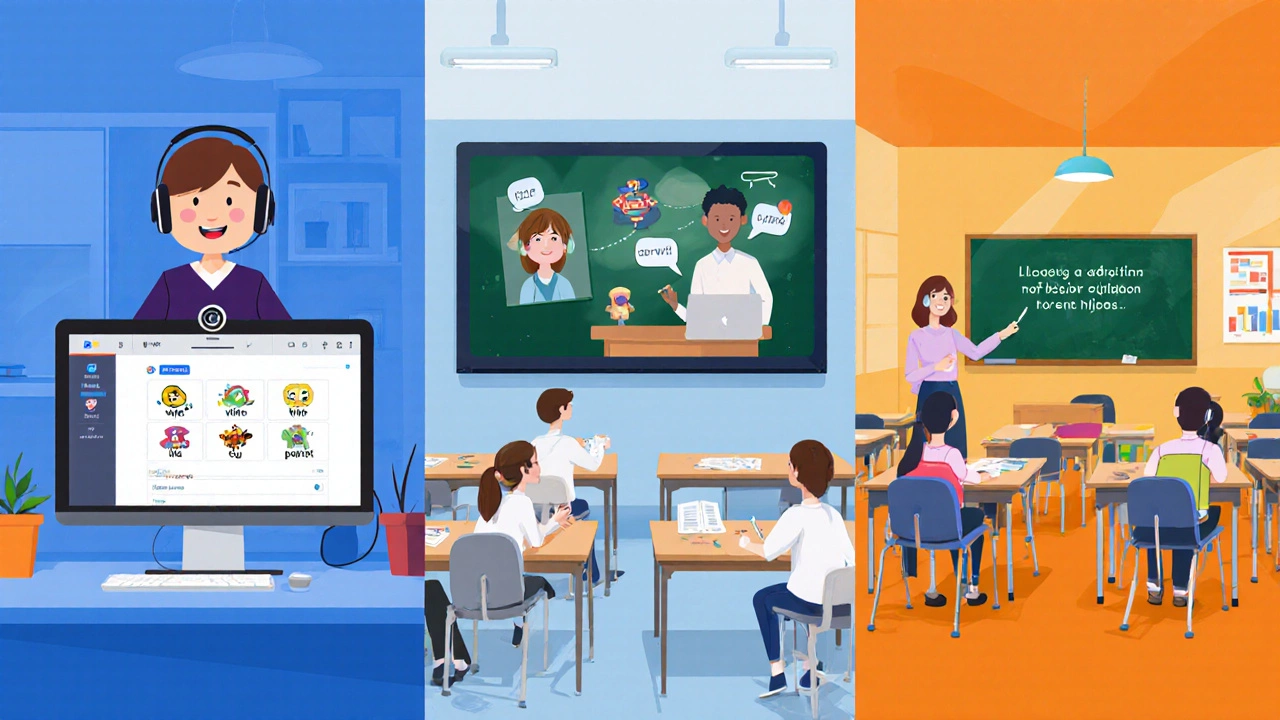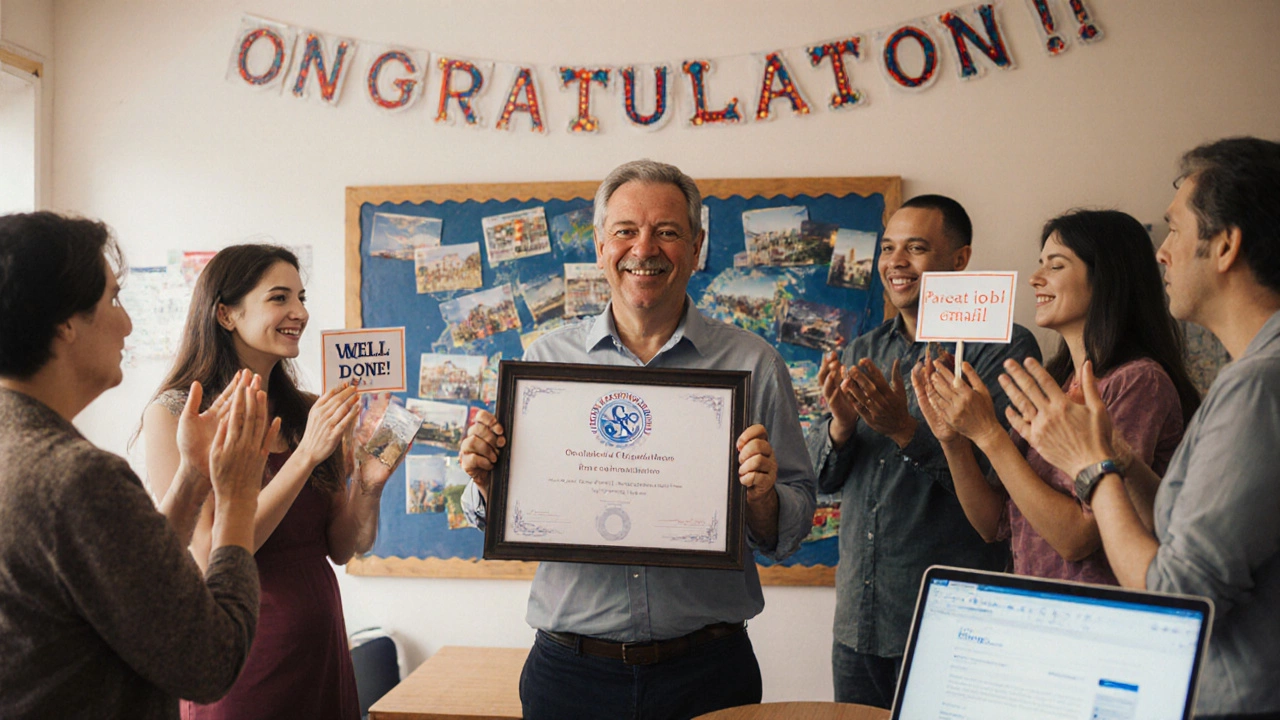Basic English Course Planner
Your personalized course recommendation will appear here after you select your preferences.
When you hear the term Basic English Course is a beginner‑level program that teaches essential English skills-reading, writing, speaking, and listening-using simple vocabulary and clear grammar explanations. It’s the stepping stone for anyone who wants to move from “I know a few words” to holding everyday conversations with confidence.
Key Takeaways
- A basic English course covers the four core skills: reading, writing, speaking, and listening.
- Typical curricula focus on everyday vocabulary, basic grammar, and pronunciation.
- Courses are offered online, in‑person, or in hybrid formats, each with its own pros and cons.
- Ideal for beginners, immigrants, travelers, and professionals needing workplace English.
- Choosing the right program involves checking length, cost, certification, and teaching style.
What Exactly Is a Basic English Course?
The English language is spoken by over 1.5billion people worldwide, so a solid foundation opens doors in education, career, and travel. A basic English course is designed for learners with little to no prior exposure. It starts with the alphabet, simple greetings, and everyday phrases, then builds up to short paragraphs and basic conversations.
Most programs follow a curriculum that mixes four skill areas:
- Reading - recognizing letters, common words, and simple texts such as signs or menus.
- Writing - forming sentences, filling out forms, and writing brief emails.
- Listening - understanding spoken directions, announcements, and basic dialogues.
- Speaking - pronouncing sounds correctly, introducing yourself, and asking everyday questions.
Unlike advanced courses that dive deep into literature or complex grammar, the focus stays on communication you can use right away.
Core Topics You’ll Encounter
Every reputable basic English course touches on these staple topics:
- Alphabet and phonetics - how each letter sounds and common pronunciation tricks.
- Basic grammar - simple present tense, articles (a, an, the), and question forms.
- Vocabulary - everyday words related to food, travel, work, and family.
- Numbers and time - telling the time, dates, and handling money.
- Pronunciation - mastering sounds that don’t exist in many native languages.
Many courses also sprinkle cultural notes-like polite expressions in the UK versus the US-to help learners sound natural.

Delivery Formats: Online, In‑person, or Hybrid?
Where you study can affect motivation, cost, and speed. Below is a quick side‑by‑side look at the three main delivery methods:
| Aspect | Online | In‑person |
|---|---|---|
| Flexibility | Study anytime, anywhere; recordings help review. | Fixed schedule; you must attend class sessions. |
| Interaction | Live video chats, forums, and AI‑powered feedback. | Face‑to‑face practice, immediate correction. |
| Cost | Generally lower; no commuting or facility fees. | Higher; includes classroom space and materials. |
| Accountability | Self‑discipline needed; progress tracked digitally. | Peer pressure and teacher oversight keep you on track. |
| Best For | Busy professionals, remote learners, budget‑conscious students. | People who thrive on real‑time interaction and immediate feedback. |
Hybrid models blend both worlds-live sessions online paired with occasional in‑person workshops. Choose what matches your schedule, learning style, and budget.
Who Should Enroll?
Not everyone needs a basic English course, but if any of the following describe you, it’s worth a look:
- You just arrived in an English‑speaking country and need to navigate daily life.
- You’re preparing for an entry‑level job that requires simple communication.
- You’re a student planning to study abroad and need to pass a basic proficiency test.
- You travel frequently and want to order food, ask for directions, and make small talk.
- You’re a parent wanting to support a child who is learning English at school.
Even native speakers sometimes take a refresher to brush up on formal writing or pronunciation for professional settings.
How Long Does It Take?
Most beginner programs run between 8 and 12 weeks, with 2-3 hours of instruction per week. Intensive bootcamps compress the same material into 4-6 weeks, demanding daily practice. If you’re juggling work or family, a slower pace (12-20 weeks) lets you absorb concepts without burnout.
Progress is measured by milestones: completing a short dialogue, writing a simple email, understanding a basic news article. Consistency beats cramming-studying 30 minutes a day beats a single four‑hour marathon.

Choosing the Right Course: A Quick Checklist
Before you click “Enroll,” run through this list:
- Accreditation - Look for recognized institutions or reputable ESL providers.
- Curriculum depth - Verify that reading, writing, listening, and speaking are all covered.
- Class size - Smaller groups (5-10 students) often mean more speaking time.
- Teacher credentials - Certified teachers with experience in teaching beginners are ideal.
- Assessment method - Some programs offer a final certificate that employers recognize.
- Cost vs. value - Compare tuition, materials, and any hidden fees.
- Technology platform - If online, ensure the site supports video, interactive quizzes, and reliable audio.
- Trial class - Many providers let you attend a free session; use it to gauge teaching style.
Answering these questions narrows the field to a handful of programs that truly fit your goals.
Common Pitfalls and How to Avoid Them
- Skipping practice - Listening to a podcast or speaking with a buddy once a week isn’t enough. Build daily micro‑sessions.
- Focusing only on grammar - Grammar is a tool, not an end. Pair rules with real conversation.
- Choosing the cheapest option - Low cost can mean unqualified teachers or outdated materials.
- Ignoring feedback - Whether from an AI grammar checker or a human instructor, act on corrections quickly.
- Setting unrealistic goals - Expecting fluency in a month leads to frustration. Aim for measurable milestones instead.
Mini FAQ
Do I need any prior knowledge to start a basic English course?
No. These courses assume you know the alphabet at most. All vocabulary and grammar are taught from scratch.
Can I get a certificate after finishing?
Many reputable providers issue a completion certificate that signals you’ve mastered the basics. Check the course description for accreditation details.
How much time should I study each day?
Even 15‑30 minutes of focused practice daily yields steady progress. The key is consistency, not marathon sessions.
Is an online basic English course as effective as a classroom?
Effectiveness depends on your learning style. Online courses offer flexibility and often lower cost, while classrooms provide instant feedback and real‑time speaking practice. Choose the format that keeps you engaged.
What age groups enroll in basic English courses?
Anyone from school‑age children to retirees can join. Providers may offer separate groups for kids, adults, or mixed‑age learners.
Next Steps
Now that you know what a basic English course looks like, take a quick inventory:
- Do you need a flexible schedule? Look for online options.
- Do you thrive on face‑to‑face interaction? Search local community colleges or language centers.
- What’s your budget? Compare tuition and any hidden fees.
Pick two or three programs that meet these criteria, attend a trial lesson, and decide which feels most supportive. Remember, the best course is the one you’ll actually stick with.
Good luck, and enjoy the journey from “hello” to confident conversation!
